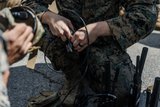How to build navigational resilience for your military in a hackable world
An anti-drone jammer, the NEROD F5-5. (Photo: French Army, Licence Ouverte, via Wikimedia Commons)
QinetiQ, a UK-based defence and technology company, recently announced plans to expand its current facility for testing the position, navigation and timing (PNT) resilience of British defence assets. The company will build a new £20 million (US$26 million) facility at the Boscombe Down military base, which will be large enough and sophisticated enough to test the resilience of some of the UK’s largest defence assets, including Protector drones, Chinook helicopters and even the F-35 fighter jet.
But how crucial is PNT resilience in the 21st century? Why is it worth spending so much money to test a single
Already have an account? Log in
Want to keep reading this article?
More from Digital Battlespace
-
![Australia looks towards space with force restructure, investment and training]()
Australia looks towards space with force restructure, investment and training
Australia is looking to improve its presence in space with a focus on communications and creating a dedicated segment of its defence forces committed to the domain.
-
![EID to unveil new vehicle communication system at DSEI]()
EID to unveil new vehicle communication system at DSEI
The Portuguese company’s naval communications system is in service across more than a dozen countries. It has turned to its home nation for support in developing a new vehicle based C2 system.
-
![Chess Dynamics successfully demonstrates Vision4ce AI-driven tracker]()
Chess Dynamics successfully demonstrates Vision4ce AI-driven tracker
The Vision4ce Deep Embedded Feature Tracking (DEFT) technology software is designed to process video and images by blending traditional computer vision with artificial intelligence (AI) algorithms to present actionable information from complex environments.
-
![Wave Relay devices cleared for security use on commercial systems in industry trend]()
Wave Relay devices cleared for security use on commercial systems in industry trend
Persistent Systems has been cleared by National Security Agency (NSA) to transmit sensitive data on commercial networks. The devices are added to the NSA’s Commercial Solutions for Classified (CSfC) component list which also includes other companies’ products providing the same security.
-
![UK teases cyber spending boost in Strategic Defence Review ahead of “imminent” release]()
UK teases cyber spending boost in Strategic Defence Review ahead of “imminent” release
The release of the UK’s Strategic Defence Review (SDR) has been long promised as mid-year. It is possible it could be as early as 2 June although the UK Ministry of Defence (MoD) continues to play its cards close to its chest.
-
![Intelsat emphasises SATCOM resilience for SOF in contested domains (video)]()
Intelsat emphasises SATCOM resilience for SOF in contested domains (video)
Intelsat outlines how its multi-orbit SATCOM architecture is enhancing connectivity and resilience for special operations forces operating in degraded and contested environments.
























